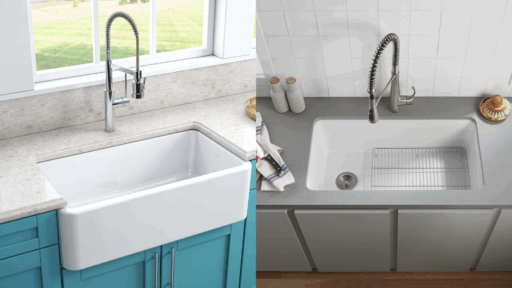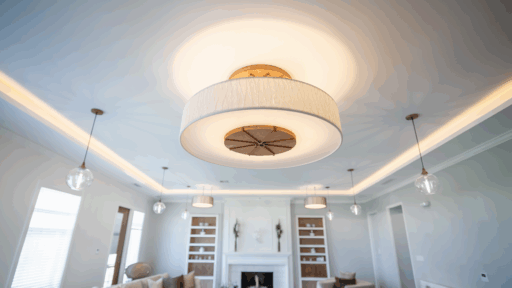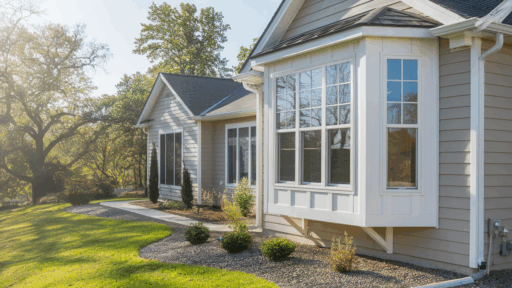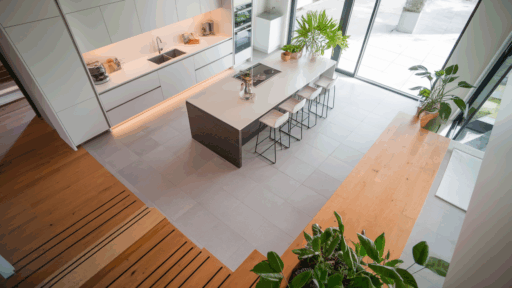When choosing a kitchen sink, two materials that often come up are fireclay and cast iron. Both are durable and have been trusted for years, but they offer distinct benefits and drawbacks.
I’ve explained the key differences between fireclay and cast iron sinks to help you make an informed decision.
Fireclay sinks are known for their sleek, modern look and resistance to stains and scratches, while cast iron sinks are praised for their longevity, heat retention, and timeless style.
However, each material has its own maintenance requirements, installation considerations, and aesthetic appeal.
In this guide, I’ll break down their advantages and disadvantages to help you determine which one best suits your needs and style preferences for your kitchen.
What is Fireclay?

Fireclay is a ceramic made by combining clay with other minerals, then firing it at high temperatures. The result is a smooth, non-porous, and durable material.
Fireclay sinks are often coated with glossy enamel, giving them a sleek, modern appearance. These sinks are resistant to stains, scratches, and chips, making them ideal for busy kitchens.
The non-porous surface also prevents odor buildup and moisture absorption, ensuring a hygienic environment. While durable, fireclay sinks can crack under heavy impact, so care is needed when handling.
Fireclay sinks are available in various colors, with white being the most common, but they can also come in other shades to complement different kitchen styles.
Their smooth surface makes them easy to clean, preventing dirt and bacteria from sticking. While fireclay is resistant to many types of damage, it can still crack or chip if subjected to very heavy impacts.
Benefits of Fireclay Sinks
Fireclay sinks are durable, scratch-resistant, easy to clean, and offer a sleek, modern look, making them a great addition to any kitchen.
- Durability: Fireclay sinks are incredibly strong, especially when compared to other ceramic materials. The firing process makes the clay resistant to chips and cracks.
- Scratch Resistance: The smooth surface of fireclay sinks makes them resistant to scratching, which is great for kitchens that use knives or other utensils regularly.
- Easy to Clean: The enamel surface is easy to wipe down, and the smooth texture makes it difficult for dirt or grime to stick.
- Aesthetic Appeal: Fireclay sinks have a beautiful, glossy finish that gives them a modern and stylish look. They are available in various colors, with white being the most common.
What is Cast Iron?

Cast iron sinks are made by pouring molten iron into molds, where it cools and solidifies, creating a heavy, robust material known for its durability and longevity.
The resulting cast iron is resistant to dents, cracks, and wear, making it an ideal material for high-traffic kitchen environments.
These sinks are typically coated with enamel, which gives them a smooth, glossy finish and provides protection from corrosion, stains, and rust.
The enamel coating also enhances the sink’s aesthetic appeal, providing a shiny, sleek surface that is easy to maintain.
One of the key features of cast iron sinks is their excellent heat retention. The material holds heat very well, which can be beneficial for tasks like washing dishes with hot water or filling pots with boiling water.
While they are heavier than other sink materials, their durability and aesthetic appeal make them a long-lasting investment.
Benefits of Cast Iron Sinks
Cast iron sinks offer exceptional durability, heat retention, a timeless aesthetic, and resistance to scratches and dents, making them a great investment for any kitchen.
- Long-Lasting Durability: Cast iron is known for its strength and longevity. A well-maintained cast iron sink can last for decades, making it a great investment for any kitchen.
- Heat Retention: Cast iron sinks retain heat very well, which is useful for tasks like washing dishes in hot water. This can help keep water warm longer than some other sink materials.
- Timeless Look: Cast iron sinks are often seen in traditional and vintage-style kitchens. They are available in a variety of colors and finishes, including glossy and matte options.
- Scratch and Dent Resistance: Cast iron is resistant to dents and scratches, especially if the enamel coating is maintained.
Pros and Cons: Fireclay Sinks vs Cast Iron Sinks
Fireclay and cast iron sinks are both popular choices for kitchens, offering durability and timeless style.
Fireclay Sinks
| Pros | Cons |
|---|---|
| Durable and resistant to scratches | Can crack or chip from heavy impact |
| Non-porous and stain-resistant surface | Heavier than standard sinks |
| Classic farmhouse style appeal | Limited in color choices (mostly white) |
| Handles high heat well | May require custom cabinetry or reinforcement |
| Smooth, glossy finish | More expensive than stainless steel or acrylic |
| Low maintenance and easy to clean | The surface can show marks from metal pans |
Cast Iron Sink
| Pros | Cons |
|---|---|
| Durable and long-lasting | Heavy and difficult to install |
| Classic, glossy enamel finish | Enamel can chip if hit hard |
| Available in many colors | Color may fade over time |
| Heat-resistant surface | Expensive compared to other options |
| Stain-resistant and easy to clean | Requires strong cabinet support |
| Reduces noise when washing dishes | Can be damaged by abrasive cleaners |
Fireclay vs Cast Iron Sinks: Key Differences
Fireclay sinks are lightweight, scratch-resistant, and offer a sleek, modern look, while cast iron sinks are heavier, offer excellent heat retention, and have a timeless, classic design.
1. Durability and Strength
Both fireclay and cast iron sinks are durable, but they differ in how they handle wear and tear.
Cast iron is incredibly strong and resistant to dents, while fireclay sinks are less likely to chip but can be prone to cracking under heavy impact.
Cast iron sinks tend to be heavier, which makes them more resistant to damage from falls or heavy objects. However, fireclay sinks are generally more resistant to scratches and stains.
- Fireclay Sinks: Less likely to dent or chip, but more prone to cracking under extreme impact.
- Cast Iron Sinks: Extremely strong and resistant to dents, but the enamel coating can crack or chip if hit hard enough.
2. Maintenance and Cleaning
Both fireclay and cast iron sinks are relatively easy to clean, but the way you maintain them differs. Fireclay sinks are easy to wipe down and maintain because of their smooth, non-porous surface.
Cast iron sinks require a bit more care, especially when it comes to the enamel coating. If the enamel gets chipped, the iron beneath can be exposed to moisture, which can lead to rusting.
- Fireclay Sinks: Smooth and easy to clean, with a non-porous surface that resists stains.
- Cast Iron Sinks: Require more care to maintain the enamel, as chips in the coating can expose the iron to rust.
3. Weight and Installation
Cast iron sinks are heavier than fireclay sinks, which can make them more difficult to install. While fireclay sinks are still heavy, they tend to be easier to handle and install because they are not as dense as cast iron.
This means that you may need extra help or support for installing a cast iron sink, especially if it’s a large model.
- Fireclay Sinks: Easier to install due to their lighter weight, but still require professional help for proper placement and support.
- Cast Iron Sinks: Heavier and may require additional support during installation.
Fireclay vs Cast Iron Sink: Which One is Right for You?
Choosing between a fireclay and cast iron sink comes down to your personal preferences, budget, and the style you’re aiming for in your kitchen.
If you want a sink that’s easy to maintain, resistant to stains and scratches, and offers a sleek, modern look, a fireclay sink could be the ideal choice.
It’s a great option if you’re looking for something functional and stylish without breaking the bank.
On the other hand, if you’re willing to invest a bit more for exceptional durability, heat retention, and a timeless aesthetic, a cast iron sink may be the right fit.
Cast iron sinks are especially suited for those who prefer a classic, vintage look and need a sink that will last for decades.
Ultimately, both materials offer great benefits, and your choice will depend on the type of kitchen you have and what qualities matter most to you.
Conclusion
Both fireclay and cast iron sinks offer distinct advantages, making them great choices depending on your needs. Fireclay sinks are durable, easy to clean, and provide a sleek, modern look at an affordable price.
They’re perfect for those who want a stylish yet practical option.
Cast iron sinks, on the other hand, provide exceptional durability, heat retention, and a timeless, classic aesthetic, ideal for those who prioritize long-lasting quality.
When choosing between fireclay and cast iron, consider your kitchen’s design, the level of maintenance you’re willing to handle, and your budget.
Both sink materials enhance a kitchen’s functionality and style, so take the time to weigh the pros and cons.
Ready to upgrade your kitchen with a new sink? Look for different options, and choose the one that best suits your needs today.








